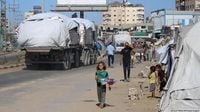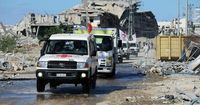On the battered streets of Khan Younis, Gaza, survivors picked their way through rubble on October 13, 2025, seeking desperately needed aid. The scene, captured by Abdelrahman Rashad for AFP/Getty Images, offered a stark reminder of the devastation wrought by two years of war between Israel and Hamas. Yet, as dawn broke the next day, a fragile hope hung in the air—a US-brokered ceasefire, celebrated by President Donald Trump in Egypt just hours earlier, was supposed to be holding. But the reality on the ground was anything but simple.
President Trump, never one to mince words, demanded on October 14 that Hamas return the bodies of deceased Israeli hostages. He threatened retaliation if the militant group failed to lay down its arms, according to Bloomberg. "ALL TWENTY HOSTAGES ARE BACK AND FEELING AS GOOD AS CAN BE EXPECTED. A big burden has been lifted, but the job IS NOT DONE," Trump posted on his Truth Social network, as reported by the BBC. "THE DEAD HAVE NOT BEEN RETURNED, AS PROMISED! Phase Two begins right NOW!!!"
Trump’s statement marked the start of what he called "phase two" of the ceasefire deal. Under the agreement, Hamas was required to release the remains of all deceased hostages within 72 hours of the ceasefire announcement. However, the return of bodies has been slow and contentious. On October 14, the Israeli army confirmed that four coffins bearing the remains of hostages had crossed into Israel from Gaza, transported by the Red Cross. The bodies were taken to the National Institute for Forensic Medicine in Tel Aviv for identification, with authorities promising to notify families first. This left the remains of 20 hostages still in Hamas’s hands, a point of deep frustration for Israeli officials.
"Hamas is required to uphold the agreement and take the necessary steps to return all the hostages," the Israel Defense Forces (IDF) posted on X (formerly Twitter), urging the public to act "with sensitivity" and wait for official identification. Four more coffins were reportedly handed to the Red Cross later that day, but, unlike previous transfers, Hamas did not provide the names of the deceased. The International Committee of the Red Cross noted that the process of recovering and returning remains could take days or even weeks, given the widespread destruction in Gaza.
The slow pace of returns has had immediate consequences. Israel informed the United Nations that it would only allow 300 aid trucks into Gaza—half of what the country had committed to under the ceasefire. The Israeli government blamed Hamas for this decision, citing the group’s failure to hand over all the hostages’ remains. According to Reuters, Hamas was expected to hand over four more bodies on the night of October 14, but Israeli officials suspected the militant group was holding onto the remains as leverage in ongoing negotiations.
Meanwhile, the ceasefire itself remained precarious. On October 14, the Israeli military reported opening fire on "suspects" who approached its forces in the northern Gaza Strip, resulting in the deaths of at least six Palestinians, according to Gaza health authorities. The IDF stated, "The IDF urges Gaza residents to follow instructions and keep their distance from IDF troops." Hamas, for its part, accused Israel of violating the truce, while Israeli Defense Minister Israel Katz accused Hamas of breaching the ceasefire and hostage-prisoner exchange deal. Katz pointed out that Israel had released nearly 2,000 Palestinian prisoners as part of the agreement, but all hostages—living and dead—were supposed to be handed over on October 13.
Amid these tensions, Hamas fighters were seen regaining control of Gaza’s cities and neighborhoods, especially in areas where Israeli forces had withdrawn. Black-masked police patrolled the streets of Gaza City, and, according to the BBC, Hamas executed dozens of its opponents in efforts to reassert authority. The group also launched operations against well-armed clans and gangs, while some clans signaled willingness to cooperate with Hamas’s law-and-order campaign. Hamas has controlled Gaza since 2007, and despite losing top leaders and facing weakened allies, it remains a powerful force—armed, organized, and deeply entrenched.
Israel, along with the US, UK, and EU, labels Hamas a terror organization and insists the group must disarm and play no part in any future government of Gaza. Trump’s 20-point peace plan, signed in Egypt, calls for a demilitarized Gaza and offers amnesty to Hamas fighters who voluntarily decommission their weapons. However, the plan leaves open crucial questions: Who will enforce disarmament? Can the unpopular Palestinian Authority take over governance? And, perhaps most importantly, what role will the international community play in rebuilding and securing Gaza?
Europe, sidelined by the US in the peace process, is eager to contribute to Gaza’s future. The BBC reports that European nations are determined to help oversee a transitional government and provide aid, but without a seat at Trump’s "Board of Peace," their influence may be limited. Meanwhile, the United Nations has stated that countries around the world are poised to help rebuild Gaza, but the path forward remains uncertain as long as governance and security issues are unresolved.
The ceasefire agreement also required Israel to return the bodies of Palestinians who died in Israeli custody. On October 14, France’s AFP reported that Israel had handed over the remains of 45 Palestinians at Nasser Medical Center in Khan Younis, as part of a deal that called for the return of 15 Palestinian bodies for every one deceased Israeli hostage. "The remains of 45 martyrs arrived at the hospital via the Red Cross as part of the exchange agreement," the hospital stated.
In Israel, the Hostages and Missing Families Forum called for "the immediate suspension" of the deal with Hamas until every deceased hostage is returned. Israeli media reported that the government suspects Hamas is retaining some remains as bargaining chips for future negotiations. Sources close to Hamas argued that adequate equipment and time are necessary to recover the bodies amid the devastation, but these claims have not satisfied Israeli authorities.
President Trump, flying aboard Air Force One, acknowledged the complexity of the situation. He told journalists, "I will decide what I think is right" to establish long-lasting peace between Israel and Palestinians. He noted divergent views on the one-state versus two-state solution, saying, "A lot of people like the one-state solution, some people like the two-state solutions. We'll have to see." While around three-quarters of UN member states recognize the Palestinian state, the US remains Israel’s closest ally and has condemned recent moves by Britain and Canada to recognize Palestine.
As the dust settles over Gaza, the region finds itself at a crossroads. The ceasefire, though welcome, is fragile, and the return of hostages remains a deeply emotional and political issue. The world watches closely, hoping that the current pause in violence can be transformed into a lasting peace. But with so many questions unanswered—and so many wounds still fresh—the journey to stability and justice is far from over.


